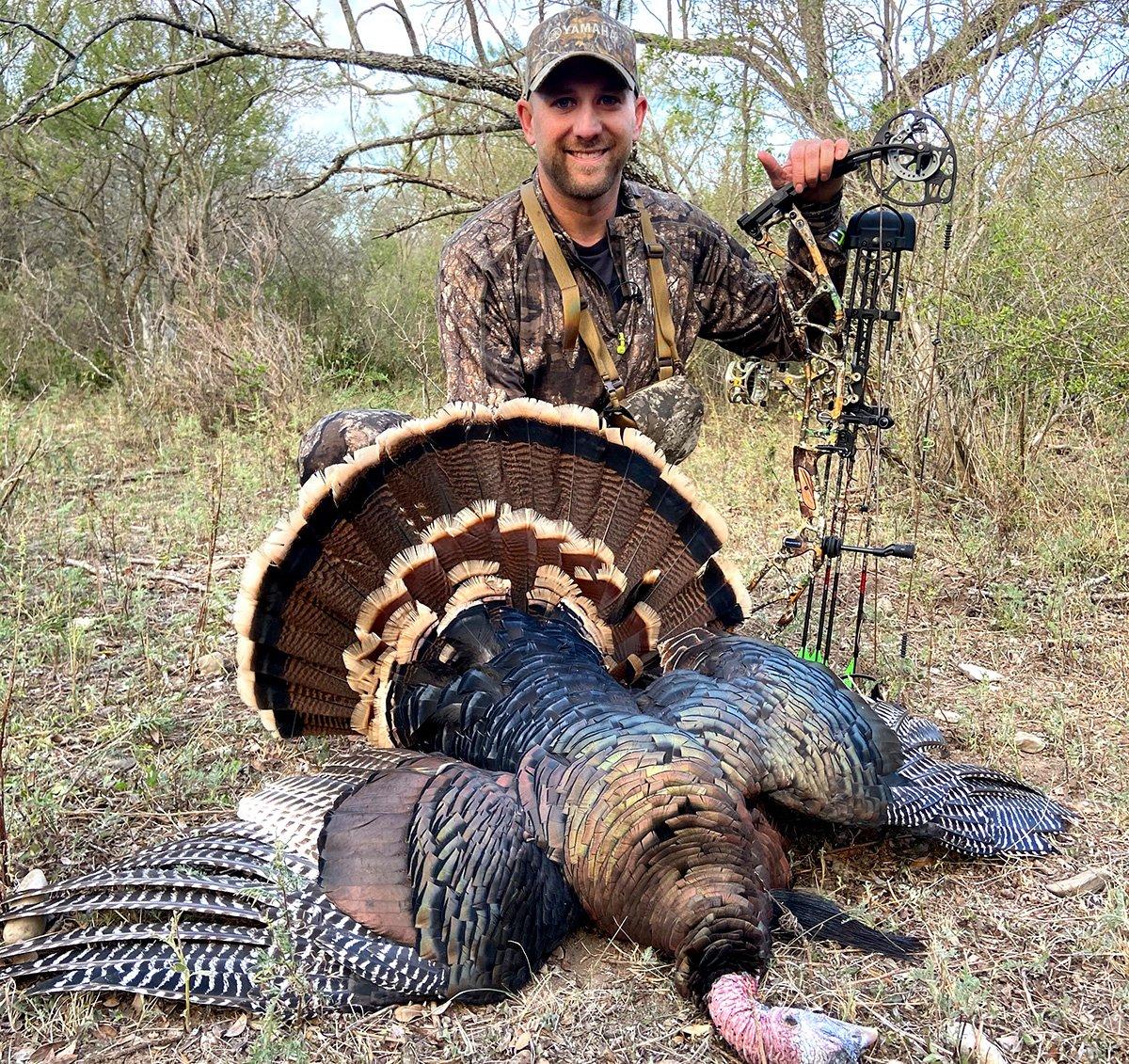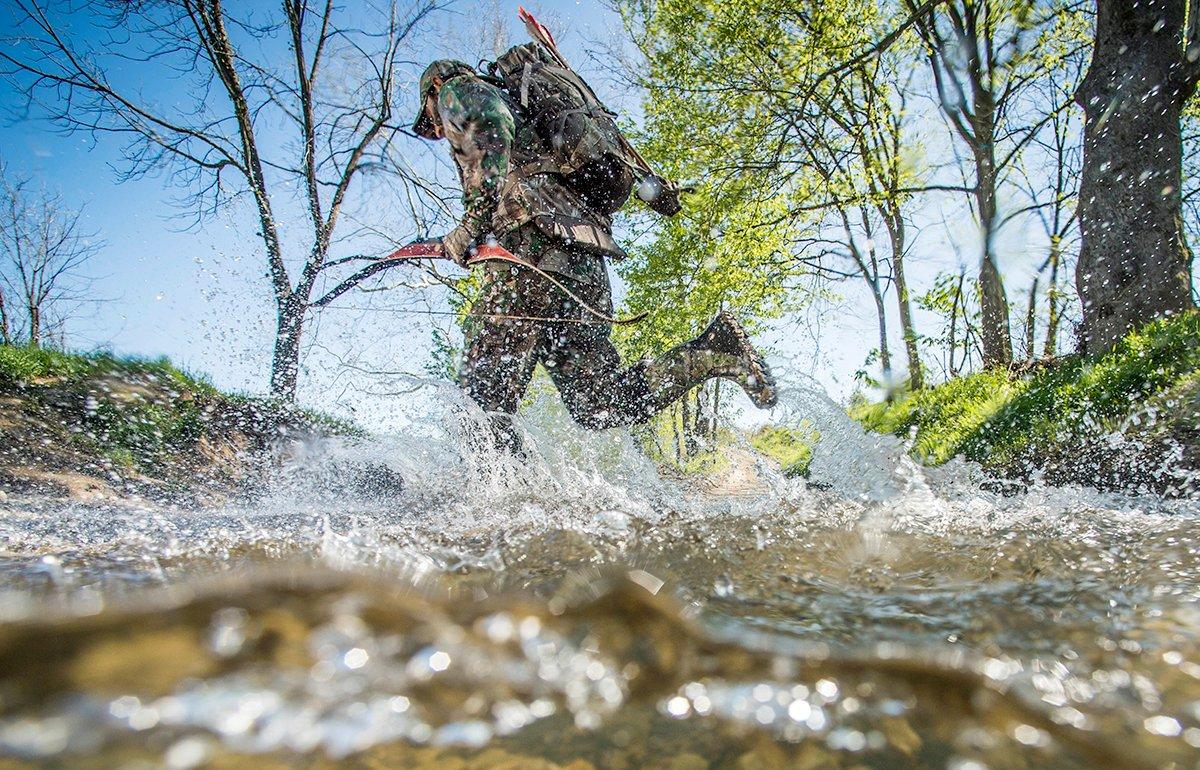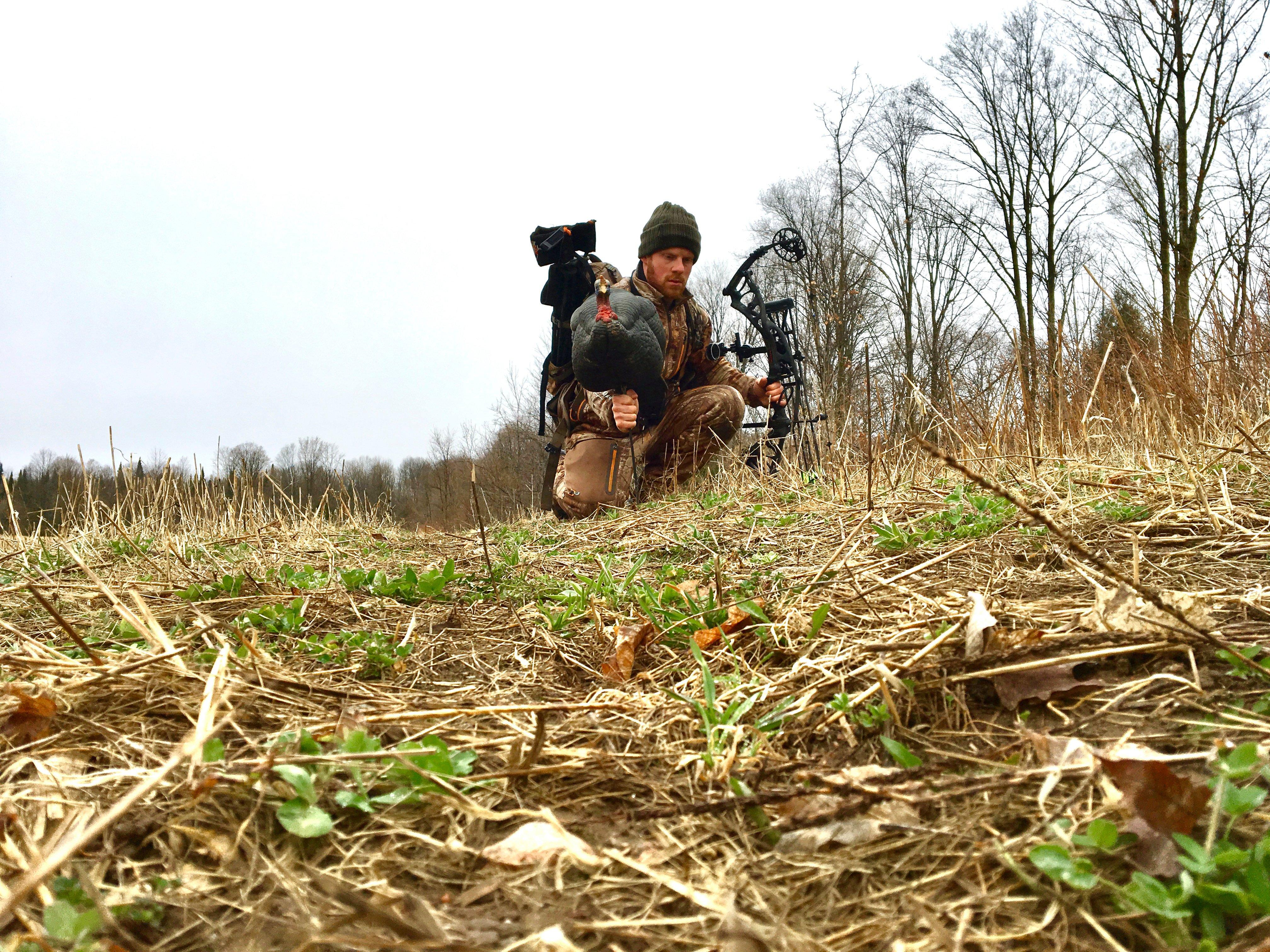Can you arrow a longbeard without a blind? Sure you can, but it won’t be easy
I’d overslept my alarm, and the tom that had eluded me the previous few mornings was already in the field where my ground blind sat empty. My only option was to cut some distance, get hidden, and attempt to fool him at top-pin distance without the security of my ground blind. Challenge accepted.
During my tactical operation, the tom moved into the timber and gobbled hard. Reaching a suitable ambush within 125 yards of the bird, I carefully crawled 15 yards off the field edge and planted a single hen decoy in the dirt before scrambling back to a pine tree. If the tom came in, a low-hanging pine bough would easily disguise the motions of drawing my bow. Then, I’d thump him as he cleared the bough and posed next to the fake lady. At least, that was the plan.
And 10 minutes later, the plan worked flawlessly. My perfectly placed arrow crumpled the bird instantly. The following week, I arrowed another big tom without a ground blind. I knew I’d found my niche, and since those hunts 11 seasons ago, I’ve arrowed many more longbeards without a blind than with one.
Why even try that? Everyone knows ground blinds make bowhunting easier. While that can be true, being mobile and moving on gobbling birds the way shotgunners do is wildly advantageous. Rather than wait for the action to unfold where you blind is parked, you can go find the action. And if you can beat a turkey’s eyesight and place a deadly hit, you can successfully run and gun with a bow.
If that sounds like something you’d like to try this spring, these tips will improve your odds.
Good Camo, Good Hiding Spot

Turkeys have phenomenal eyesight that saves their lives more than any other sense. Virtually nothing goes unnoticed. Several times I’ve even been caught moving at the wrong time inside a ground blind; imagine how easily turkeys can bust hunters sitting in the open.
Rather than wait for the action to unfold where you blind is parked, you can go find the action.
It’s fundamental to wear camo from head to toe. I often use Realtree Edge because it’s so versatile and effective. Don’t forget to wear lightweight gloves and a face mask, too. Turkeys can easily identify something out of place, so starting with a camo outfit that melts into the surroundings is crucial.
Next, plan your setup. Don’t sit down against just any tree when a tom gobbles over your call. Instead, quickly analyze your surroundings. You must disrupt your outline as much as possible. Ideally, I prefer to sit against the shadowed side of a large tree trunk (when it’s sunny) so that I’m not highlighted. If that option doesn’t exist, I pick the least conspicuous tree trunk, or I look for a log pile, farm equipment, or brush. Background cover is more valuable than foreground cover, although having both makes the setup even deadlier. Make sure that foreground cover doesn’t obstruct your shooting coverage. If I have nothing more than a tree to sit against, I’ll prop a few logs around me so that I look like part of the mix.
Shotgun hunters can usually swat a tom through the brush as long as he’s in range, but with a bow, you need him close and completely unobstructed. Realistic decoys ultimately can orchestrate the high-percentage shot opportunity bowhunters need, but if the approaching tom cannot see them, he’ll probably stay out of range, in the brush or both.
With decoy placement complete, make some quick assumptions as to how the tom will approach them. Identify obstacles like trees, logs, or brush he’ll likely walk behind en route to the decoys. When his eyeball disappears behind a sizable obstruction a short distance from the decoys, draw back immediately and aim toward the decoys or where the tom will reappear from behind the obstruction. Complete the maneuver before his eyeball reappears so he doesn’t catch the movement.
Learn to Use Mouth Calls
I rarely use anything other than mouth calls while hunting without a blind. I store one in my cheek so that it isn’t a choking hazard as I move and set up, but whenever I need to call, I simply shift the call into position with my tongue and begin calling. It requires no visible movement. In other words, if I need to coax a tom that’s already within view just a little bit more, I can keep my bow in hand and my release attached and call with no movement. You can’t do that with a slate or box call, so learn to use a mouth call.

Use a Jake Decoy
I switched to a very realistic jake decoy about 13 seasons ago and haven’t looked back. I use it every time I bowhunt without a blind and most times when I do. The reason? Not only does it give me something like an 80 percent response rate when gobblers see it, but it usually captures their full attention, too. I lost my metal decoy stake years ago, so I replaced it with an arrow. I’ve had several arrows break from toms whacking my decoy so hard.
The aggressive behavior the decoy triggers takes the bird’s attention away from me. This is helpful when cover is sparse; he sees what looks like a real turkey, so he has no inkling that danger lurks 12-15 yards away. Plus, he has one thing on his mind: beat the tar out of that intruder. This affords me more opportunities to draw my bow in case there are few to no obstructions to hide his eyeball. I typically wait until he’s jumping all over the decoy and then easily draw back while he’s distracted.
Nothing in turkey hunting excites me more than my decoy being raided by a boss gobbler or three inside 20 yards. But, don’t let the excitement cause you to rush your shot. If the tom is still fixated on your decoy once you hit full draw, you typically have way more time to shoot than you think. If he’s beating a decoy, he’s in a zone. I like to wait until the initial beating subsides and the tom is no longer a blur. Never shoot when he’s lunging at the decoy, because even 2 inches of movement can spell the difference between a perfect hit and a marginal shot. Slow down, settle in, and let the bird hold still.

Keep Moving
We’ve covered the scene of a successful encounter, but what if the first setup flops? Just like shotgunners, use the terrain and cover to make moves on bird that is talking but not committing to your initial setup. I keep my phone rigged with a mapping app so that I can quickly overview the terrain and any land features that can help me close the distance. I also can use it to predetermine possible setups based on the given terrain and land features.
The entire reason to hunt without a blind is so that you can move around and stay in the action. So, don’t park by a tree and wait for the action to come to you. Go get on that gobbling bird and try calling to him from another angle.
Get Close
Finally, get close. Often, the reason ground-blind setups don’t produce is because you’re limited in how close you can get to a bird — roosted or on the ground — since setting up a blind involves some commotion and movement. You don’t have that hitch when you leave your ground blind in the truck. Typically, you can sneak in closer and set up without all the ruckus. That often puts you in a more likely position to call and decoy the bird.
This was the case with my first blind-less tom ever, a bird I tagged on a 40-acre piece of public ground 12 years ago. I would’ve set up at least 150 yards away had I been toting a ground blind, since conditions were calm and daylight had nearly arrived by the time he said his first word from the roost. But, since I was blind-less, I tiptoed to within 80 yards and set up. A few tree yelps and shaking my hat to simulate a hen flying down piqued his curiosity, and he flew down and strutted right to my decoy before taking an arrow through the lungs from 15 yards.
Yes You Can!
Bowhunting turkeys with a blind is highly advantageous, and I still use one a lot, especially on private-land birds I have patterned. But, when I’m hunting a new area or simply haven’t pre-scouted before my hunt, I typically leave the blind in the truck and go running and gunning (maybe running and bow-ing is a more accurate depiction).
Can you successfully run and gun with a bow? Yes, as long as you can beat a tom’s eyesight using the steps I outlined above and place a deadly shot with your bow. Think you have what it takes? Then, give it a go this spring










